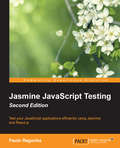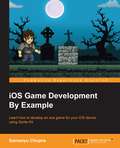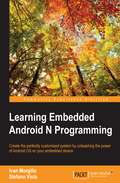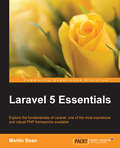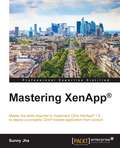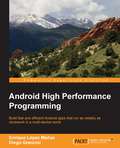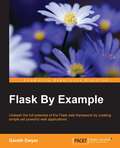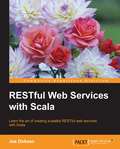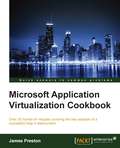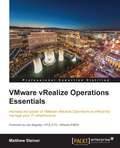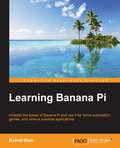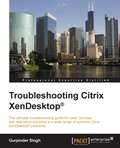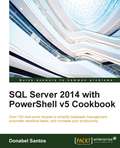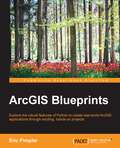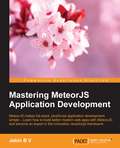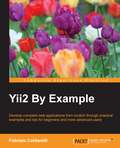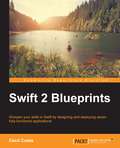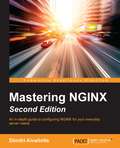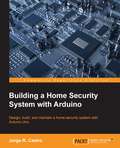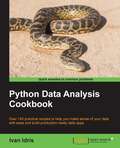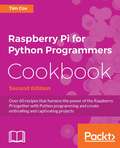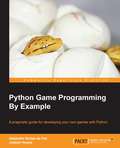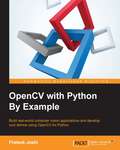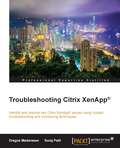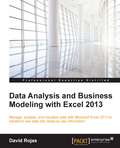- Table View
- List View
Jasmine JavaScript Testing - Second Edition
by Paulo RagonhaThis book is for web developers and designers who work with React.js and JavaScript and who are new to unit testing and automation. It's assumed that you have a basic knowledge of JavaScript and HTML.
iOS Game Development By Example
by Samanyu ChopraLearn how to develop an ace game for your iOS device, using Sprite Kit About This Book * Learn about the Sprite Kit engine and create games on the iOS platform from the ground up * Acquaint your Sprite Kit knowledge with Swift programming and turn your 2D game conceptualization into reality in no time * An abridged and focused guide to develop an exhaustive mobile game Who This Book Is For This book is for beginners who want to start their game development odyssey in the iOS platform. If you are an intermediate or proficient game developer hailing from a different development platform, this book will be a perfect gateway to the Sprite Kit engine. The reader does not need to have any knowledge of Sprite Kit and building games on the iOS platform. What You Will Learn * Learn about the Sprite Kit game engine and create indie games in no time * Set sail on the quest of game development career by successfully creating a runner game * Know more about the IDE provided by Apple for game development - Xcode * Get an overview of Apple's latest programming language, Swift * Discover the functionalities of scenes and nodes in a game * Explore how physics bodies work and how to add this feature into your game * Grasp knowledge of particle effect and shaders * Add a scoring system into your game to visualize high scores In Detail Game development has always been an exciting subject for game enthusiasts and players and iOS game development takes a big piece of this cake in terms of perpetuating growth and creativity. With the newest version of iOS and Sprite Kit, comes a series of breathtaking features such as Metal rendering support, camera nodes, and a new and improved Scene Editor. Conceptualizing a game is a dream for both young and old. Sprite Kit is an exciting framework supported by Apple within the iOS development environment. With Sprite Kit, creating stunning games has become an easy avenue. Starting with the basics of game development and swift language, this book will guide you to create your own fully functional game. Dive in and learn how to build and deploy a game on your iOS platform using Sprite Kit game engine. Go on a detailed journey of game development on the iOS platform using the Sprite Kit game engine. Learn about various features implemented in iOS 8 that further increase the essence of game development using Sprite Kit. Build an endless runner game and implement features like physics bodies, character animations, scoring and other essential elements in a game. You will successfully conceive a 2D game along with discovering the path to reach the pinnacle of iOS game development. By the end of the book, you will not only have created an endless runner game but also have in-depth knowledge of creating larger games on the iOS platform. Style and approach An easy-to-follow, comprehensive guide that makes your learning experience more intriguing by gradually developing a Sprite Kit game. This book discusses each topic in detail making sure you attain a clear vision of the subject.
Learning Embedded Android N Programming
by Ivan Morgillo Stefano ViolaCreate the perfectly customized system by unleashing the power of Android OS on your embedded device About This Book * Understand the system architecture and how the source code is organized * Explore the power of Android and customize the build system * Build a fully customized Android version as per your requirements Who This Book Is For If you are a Java programmer who wants to customize, build, and deploy your own Android version using embedded programming, then this book is for you. What You Will Learn * Master Android architecture and system design * Obtain source code and understand the modular organization * Customize and build your first system image for the Android emulator * Level up and build your own Android system for a real-world device * Use Android as a home automation and entertainment system * Tailor your system with optimizations and add-ons * Reach for the stars: look at the Internet of Things, entertainment, and domotics In Detail Take a deep dive into the Android build system and its customization with Learning Embedded Android Programming, written to help you master the steep learning curve of working with embedded Android. Start by exploring the basics of Android OS, discover Google's "repo" system, and discover how to retrieve AOSP source code. You'll then find out to set up the build environment and the first AOSP system. Next, learn how to customize the boot sequence with a new animation, and use an Android "kitchen" to "cook" your custom ROM. By the end of the book, you'll be able to build customized Android open source projects by developing your own set of features. Style and approach This step-by-step guide is packed with various real-world examples to help you create a fully customized Android system with the most useful features available.
Laravel 5 Essentials
by Martin BeanThis book is intended for PHP web developers who have an interest in Laravel and who know the basics of the framework in theory, but don't really know how to use it in practice. No experience of using frameworks is required, but it is assumed you are at least familiar with building dynamic websites in PHP already.
Mastering XenApp®
by Sunny JhaMaster the skills required to implement Citrix® XenApp® 7.6 to deploy a complete Citrix®-hosted application from scratch About This Book * Learn to implement and configure components of Citrix® XenApp® 7.6, which are XenServer®, XenApp®, Citrix® License server, PVS, Storefront, Citrix® Receiver, and Netscaler to secure WAN traffic * Build the XenApp® 7.6 environment independently and perform tests to make sure the components are working as expected for internal and external traffic * Implement advanced tools in Citrix® XenApp® to build and manage a cost effective, secure, and high-performing application delivery infrastructure with this comprehensive guide Who This Book Is For This is book is for administrators who are currently managing the implemented environment and want to learn how to deploy the Citrix® Hosted virtualization solution for the application in a windows server 2012 R2 environment. A reasonable knowledge and understanding of core XenApp® elements and concepts used during virtualizing applications are assumed. What You Will Learn * Understand how to set up Hypervisor, install the management console, configure the storage repository, and create a virtual machine on hypervisor * Set up an Infrastructure component and explore ways to tune them up so that they can be used for Citrix® environment * Set up a Domain controller, DHCP, Certificate authority, and SQL server for static database for Citrix® XenApp® * Validate the Citrix® XenApp® 7.6 solution to make sure components are communicating properly * Manage the essential Citrix® components - Director, Licensing, and Policies with the Help of Citrix® studio * Optimize the behavior of an Application and share desktop via Policies * Installing and configuring Citrix® Provisioning services to deliver Citrix® XenApp® 7.6 virtual machines * Secure the external Delivery of an application and shared desktop via netscaler to enjoy mobility In Detail Citrix® XenApp® is one of the leading pieces of Application delivery software that delivers Windows compatible apps to users on any device, anywhere. Citrix® XenApp® also gives administrators the ability to manage and control the freedom of mobility by increasing the security and saving costs at the same time. This book will provide you with all the knowledge required to successfully deploy and master a complete Citrix® hosted application. First, it will cover essential concepts of the architecture of XenApp®. You will then learn how to set up Hypervisor and how to set up Infrastructure components. Next you will learn how to Set up Citrix® Components, XenApp® resources, PVS, and Netscaler. We will further look at how to prepare the environment for Rollout. Additionally, you will learn how to configure the Citrix® components such as Citrix® Director. Moreover, you'll learn about shared desktop for delivery to end users and the application of policies for effective and secure delivery. Finally, you will learn how to implement provisioning services for a Citrix® XenApp® 7.6 environment. Style and approach This book is based on a course outline and hence takes a very practical approach so you will understand how to implement the components of XenApp® in a production environment. Complemented with many best practices and troubleshooting concepts of XenApp®, this book will help you master XenApp® swiftly.
Android High Performance Programming
by Diego Grancini Enrique Lopez ManasBuild fast and efficient Android apps that run as reliably as clockwork in a multi-device world About This Book * Wide coverage of various topics that help in developing optimal applications * Explore the concepts of Advanced Native Coding in depth * A must-have for professional-standard Android developers for whom performance failures and the sloppy use of resources are simply unacceptable Who This Book Is For This book is aimed at developers with an advanced knowledge of Android and who want to test their skills and learn new techniques to increase the performance of their applications. We assume they are comfortable working with the entire Android SDK, and have been doing it for a few years. They need to be familiar with frameworks such as NDK to use native code, which is crucial for app performance What You Will Learn * Create Android applications that squeeze the most from the limited resource capacity of devices * Swap code that isn't performing * Efficient memory management by identifying problems such as leaks * Reap the benefits of multithreaded and asynchronous programming * Maximize the security and encryption mechanisms natively provided by Android * Perform efficient network operations and techniques to retrieve data from servers * Master the NDK to write native code that can perform faster operations In Detail Performant applications are one of the key drivers of success in the mobile world. Users may abandon an app if it runs slowly. Learning how to build applications that balance speed and performance with functionality and UX can be a challenge; however, it's now more important than ever to get that balance right. Android High Performance will start you thinking about how to wring the most from any hardware your app is installed on, so you can increase your reach and engagement. The book begins by providing an introduction to state-of-the-art Android techniques and the importance of performance in an Android application. Then, we will explain the Android SDK tools regularly used to debug and profile Android applications. We will also learn about some advanced topics such as building layouts, multithreading, networking, and security. Battery life is one of the biggest bottlenecks in applications; and this book will show typical examples of code that exhausts battery life, how to prevent this, and how to measure battery consumption from an application in every kind of situation to ensure your apps don't drain more than they should. This book explains techniques for building optimized and efficient systems that do not drain the battery, cause memory leaks, or slow down with time. Style and approach The book follows a tutorial-based approach to take the reader from the basic fundamentals of debugging to advanced performance-improvement concepts.
Flask By Example
by Gareth DwyerUnleash the full potential of the Flask web framework by creating simple yet powerful web applications About This Book * The most up-to-date book on Flask on the market * Create your own world-class applications and master the art of Flask by unravelling its enigma through this journey * This step-by-step tutorial is packed with examples on blending different technologies with Flask to get you up and running Who This Book Is For Have you looked at PHP and hated the clunky bloated syntax? Or looked at .Net and wished it was more open and flexible? Maybe you've tried your hand at GUI libraries in Python and found them hard to use? If your answer to any one of these questions is a yes, then this is just the book for you. It is also intended for people who know the basics of Python and want to learn how to use it to build powerful solutions with a web front-end. What You Will Learn * Build three web applications from the ground up using the powerful Python micro framework, Flask. * Dynamically display data to your viewers, based on their requests * Store user and static data in SQL and NoSQL databases and use this data to power your web applications * Create a good user experience by combining HTML, CSS, and JavaScript * Harness the convenience of freely available APIs, including OpenWeatherMap, Open Exchange Rates, and bitly * Extend your applications to build advanced functionality, such as a user account control system using Flask-Login * Learn about web application security and defend against common attacks, such as SQL injection and XSS In Detail This book will take you on a journey from learning about web development using Flask to building fully functional web applications. In the first major project, we develop a dynamic Headlines application that displays the latest news headlines along with up-to-date currency and weather information. In project two, we build a Crime Map application that is backed by a MySQL database, allowing users to submit information on and the location of crimes in order to plot danger zones and other crime trends within an area. In the final project, we combine Flask with more modern technologies, such as Twitter's Bootstrap and the NoSQL database MongoDB, to create a Waiter Caller application that allows restaurant patrons to easily call a waiter to their table. This pragmatic tutorial will keep you engaged as you learn the crux of Flask by working on challenging real-world applications. Style and approach This book will provide you with rich, practical experience of Flask. Every technology, that is employed along with Flask is comprehensively introduced, while the book focusses on developing web applications. Pointers to educational material are always given if you want to gain in-depth knowledge of the various technologies used.
RESTful Web Services with Scala
by Jos DirksenLearn the art of creating scalable RESTful web services with Scala About This Book * This is the only book on the market that will help you create scalable RESTful web services using five popular Scala-based REST frameworks * Quickly identify the best framework for a specific problem and select the most appropriate solution to suit your requirements * This practical guide will help you implement a complete REST-based API from scratch Who This Book Is For If you are a Scala developer with some Scala experience and you want to get an overview of the frameworks that are available in the Scala world, then this book is perfect for you. You need to have a general knowledge of REST and Scala. This book is great for senior Scala (or other language) developers who are looking for a good REST framework to use together with Scala. What You Will Learn * Set up a development environment to easily develop and test REST services * Discover the different ways in which you can create REST services with Scala * See and explore the different approaches taken by popular REST frameworks * Get to know more about a variety of available Scala frameworks such as Finch, Unfiltered, Scalatra, Akka-HTTP, and Play * Discover how to create a REST service on top of each framework discussed in this book * Create HTTP clients using the frameworks in this book * Make an informed decision about which framework to use in a specific situation * Set up authentication for your REST services In Detail RESTful web services are built to work best on the web. Scala provides a rich set of language constructs and advanced frameworks that you can use to create REST services. However, using Scala and these tools can be a complex task. There are many frameworks available and choosing the wrong framework or approach can cost a lot of time and lead to much frustration. By exploring the most popular Scala REST frameworks, you can make sure you choose the right tool. RESTful Web Services with Scala begins with a brief explanation of the REST architecture and its implementation in Scala, as well as the impact that REST architecture has on Scala applications. You will understand the advantages of building Scala web services and how existing Scala applications can take advantage of REST. This book will teach developers about the different programming paradigms available in the Scala world to create RESTful services by exploring the most popular Scala-oriented REST frameworks. It discusses the various facets of RESTful web services such as building scalable APIs, working with standards like HTTP and MIME, designing the architecture, securing the web service, and more. With this book, you will be able to build RESTful web services with various Scala frameworks such as Finch, Unfiltered, Scalatra, Akka-HTTP, and Play. You will create basic REST services using frameworks and then extend the REST services with custom functionality. By the end of the book, you'll be able to decide which framework is best suited for your requirements. We finish by looking at how we can use a number of advanced features provided by these frameworks, such as security, creating HTTP clients, working with HATEOAS, and more. Style and approach This book follows a practical approach where we implement a REST API using each of the frameworks discussed. This book is filled with rich examples and code so you can understand and implement the features of every framework.
Microsoft Application Virtualization Cookbook
by James PrestonIf you have some experience with App-V but are overwhelmed by the range of features on offer, then this book is for you. A basic understanding of App-V and common Windows Server technologies (Active Directory/Group Policy/PowerShell) is necessary.
VMware vRealize Operations Essentials
by Matthew SteinerHarness the power of VMware vRealize Operations to efficiently manage your IT infrastructure About This Book * Extract the optimum performance, availability, and capacity of your IT infrastructure with the help of vRealise Operations Manager * Leverage the power of strategic reports to drive tactful decision-making within the IT department * A pragmatic guide to proficiently manage your applications and storage Who This Book Is For If you are a vSphere administrator and wish to optimize your virtual environment, this book is your go-to guide on vRealize Operations. As a vSphere administrator, it is assumed that you have a good understanding of both physical and virtual infrastructure. A basic knowledge of application monitoring and log analysis would be useful when we dive into the capabilities of the solution. What You Will Learn * Architect, design, and install vRealize Operations * Migrate from the previous vCenter Operations Manager 5.x version, configure vR Ops policies, and create custom groups * Use out-of-the-box Dashboards, Views, and Reports and create your own customized Dashboards, Views, and Reports * Apply the Alerting framework of Symptoms, Recommendations, and Actions, and create your own Alerting content * Leverage the power of Capacity Planning to maximize the utilization of your virtual infrastructure * Manage the rest of your infrastructure, including storage and applications, with vRealize Operations Management Packs * Extend the solution with vRealize Hyperic and Log Insight In Detail This book will enable you to deliver on the operational disciplines of Performance, Health, Capacity, Configuration, and Compliance by making the best use of solutions provided by vRealize Operations. Starting with architecture, design, and sizing, we will ensure your implementation of vRealize Operations is a success. We will dive into the utilization of a solution to manage your vSphere infrastructure. Then, we will employ out-of-the-box Dashboards and the very powerful Views and Reporting functionality of vRealize Operations to create your custom dashboards and address your reporting requirements. Next, we go through the Alerting framework and how Symptoms, Recommendations, and Actions are used to achieve efficient operations. Later you will master the topic of Capacity Planning, where we look at how important it is to craft appropriate policies to match your requirements, and we'll consider attitude toward capacity risk, which will aid you to build future project requirements into your capacity plans. Finally, we will look at extending the solution to manage Storage, Applications, and other IT infrastructures using Management Packs from Solution Exchange, as well as how the solution can be enhanced with the integration of Log Insight. Style and approach This book is a pragmatic, step-by-step guide that will quickly build your knowledge of the key capabilities of vRealize Operations. As well as learning about the solution, we will provide you with real-world examples that will help you customize and enhance your virtual environment.
Learning Banana Pi
by Daniel BlairThis book is for anyone who wants to explore Banana Pi and get started building projects on their own using it. No prior experience of working with single board computers is required.
Troubleshooting Citrix XenDesktop®
by Gurpinder SinghThe ultimate troubleshooting guide for clear, concise, and real-world solutions to a wide range of common Citrix XenDesktop problemsAbout This BookExplore the XenDesktop architecture and work with various troubleshooting tools that every Citrix admin should know aboutDiscover how to troubleshoot performance, VDA registration, and NetScaler integration issuesA fast-paced troubleshooting guide to help you identify and resolve any kind of problem you might face while working with Citrix XenDesktopWho This Book Is ForTroubleshooting Citrix XenDesktop is targeted at Citrix Administrators or Citrix Engineers who are working on Xendesktop and want to learn tips and techniques required to deal with the issues they face in their day-to-day life. A working knowledge of core elements and concepts of Xendesktop would be an added advantage.What You Will LearnSolve VDA registration problems and Citrix session launch difficultiesIdentify and resolve XenDesktop service issuesTroubleshoot performance issues related to the XenDesktop architectureWork around common printing issuesUnderstand the Citrix XenDesktop HDX policies and deal with the HDX MediaStream challengesResolve the common MCS and PVS configuration issues in your XenDesktop environmentFind solutions to some general issues that have been identified and recorded by Citrix in their database that every administrator must be aware ofIn DetailIn today's world, many organizations have decided to move to secure and stable VDI platforms to benefit their organization to meet their security needs. To meet an organization's requirements, Citrix XenDesktop serves as the best desktop virtualization solution available, providing the optimum user experience.Troubleshooting Citrix XenDesktop is a single resource guide that will help you dig deep into all the technical issues you encounter to resolve them using an autonomous and well-defined approach.The book starts by walking you through the XenDesktop architecture and the troubleshooting toolkit for Citrix XenDesktop. The subsequent chapters will help you identify possible causes of various types of Citrix XenDesktop problems that may arise while installing, configuring, or troubleshooting day-to-day problems. You will also be dealing with the most common and important VDA registration problems that you might often face while working with the XenDesktop product suite. Additionally, you will resolve issues that arise while launching Citrix sessions, troubleshoot performance issues, and learn how to integrate Citrix NetScaler with your XenDesktop environment.Style and approachThis book is an easy-to-follow troubleshooting guide with real-world examples of resolving XenDesktop issues. Each chapter is focused on a specific troubleshooting area, giving you the time to learn about and apply relevant tools and practices to troubleshoot the problems using a systematic approach.
SQL Server 2012 with PowerShell V3 Cookbook
by Donabel SantosSQL Server 2012 with PowerShell V3 Cookbook" is an example-focused book that provides step-by-step instructions on how to accomplish specific SQL Server tasks using PowerShell. Each recipe is followed by an analysis of the steps or design decisions taken, and additional information about the task at hand. Working scripts are provided for all examples so that you can dive in right away. You can read this book sequentially by chapter, or you can pick and choose which topics you need right away,This book is written for the SQL Server database professional (DBA, developer, BI developer) who wants to use PowerShell to automate, integrate, and simplify database tasks. A little bit of scripting background is helpful, but not necessary.
ArcGIS Blueprints
by Eric PimplerExplore the robust features of Python to create real-world ArcGIS applications through exciting, hands-on projects About This Book * Get to grips with the big world of Python add-ins and wxPython in GUI development to implement their features in your application * Integrate advanced Python libraries, ArcPy mapping, and data access module techniques to develop a mapping application * Construct a top-notch intermediate-to-advanced project by accessing ArcGIS Server and ArcGIS Online resources through the ArcGIS REST API using a project-based approach Who This Book Is For If you have prior experience building simple apps with ArcGIS and now have a fancy for developing a more challenging and complex desktop application in ArcGIS, then this book is ideal for you. What You Will Learn * Automate the creation of creative output data visualizations including maps, charts, and graphs * Explore ways to use the ArcPy Mapping module and Data-driven Pages to automate the creation of map books in your own project * Develop applications that use the Plotly platform and library to create stunning charts and graphs that can be integrated into ArcGIS Desktop * Build tools that access REST services and download data to a local geodatabase * Design, build, and integrate advanced GUIs with wxPython and ArcGIS Desktop in ArcGIS * Get clued up about constructing applications that export data to Google Earth Pro to automate time-consuming complex processes * Maximize the access of ArcGIS Server and ArcGIS Online using the ArcGIS REST API with Python In Detail This book is an immersive guide to take your ArcGIS Desktop application development skills to the next level It starts off by providing detailed description and examples of how to create ArcGIS Desktop Python toolboxes that will serve as containers for many of the applications that you will build. We provide several practical projects that involve building a local area/community map and extracting wildfire data. You will then learn how to build tools that can access data from ArcGIS Server using the ArcGIS REST API. Furthermore, we deal with the integration of additional open source Python libraries into your applications, which will help you chart and graph advanced GUI development; read and write JSON, CSV, and XML format data sources; write outputs to Google Earth Pro, and more. Along the way, you will be introduced to advanced ArcPy Mapping and ArcPy Data Access module techniques and use data-driven Pages to automate the creation of map books. Finally, you will learn advanced techniques to work with video and social media feeds. By the end of the book, you will have your own desktop application without having spent too much time learning sophisticated theory. Style and approach This is an easy-to-follow, project-based guide that guides you through the whole ArcGIS theme with practical, real-world examples and a systematic approach.
Mastering MeteorJS Application Development
by Jebin B VMeteorJS makes full-stack JavaScript Application Development simple - Learn how to build better modern web apps with MeteorJS, and become an expert in the innovative JavaScript framework About This Book * Get your dream project up and running by building exceptional MeteorJS applications in a matter of days * Learn how to integrate other JavaScript frameworks into your MeteorJS project and become an expert in full-stack development * Go beyond coding and learn how to make modern design decisions - from mobile design to SEO - that drive great user experiences Who This Book Is For If you've already had some experience with MeteorJS but want to learn how to build even better modern web application, this book has been created for you. It provides you with a comprehensive look at one of those most important frameworks being used for the modern web today. What You Will Learn * Get to grips with the basics and learn how to build a complete real-time application with MeteorJS * Find out how Meteor makes full-stack development simple - become a better developer, fast. * Use some of the most effective testing tools in modern web development to troubleshoot, debug and optimize your app * Find out how to write custom packages for applications - so you can build your project exactly how you want * Integrate React and Angular into your project * Design and develop high quality animations that will give your UI the edge * Build MeteorJS to serve as REST-based application and reactive system * Learn how to host a MeteorJS application and then scale it for data * Find out how MeteorJS can help you build for mobile * Learn how to make sure you implement an effective SEO strategy in your MeteorJS application In Detail The web is dead - applications now rule our online experiences. But how are you going to build them? Well, if you've been paying attention, you might already have tried your hand with MeteorJS, the JavaScript framework that helps you build complete full-stack web applications that are responsive and fast with ease. Mastering MeteorJS Application Development shows you how to do even more with MeteorJS - if you're ready to try a comprehensive course through one of the most exciting frameworks in web development today, this is the book you need. Designed to take you through the entire process of building an advanced multipage application with Meteor, you'll be able to bring your web development ideas with surprising ease. You'll not only learn how Meteor makes web development easier, but also how you can make using Meteor easier, by automating and simplifying tasks so you can be confident you have full control of everything in your workflow - especially everything that could go wrong. From automated testing to integrating other useful frameworks such as Angular and D3, each chapter covers a crucial element in the Meteor development process. Discover how to integrate animations using Meteor's Blaze, to give your UI designs the edge, and explore reactive programming to effectively harness RESTful systems in your projects. You will also learn how to deploy and scale your application, two crucial aspects of modern development and vital in a changing digital environment with users expecting a product and experience that delivers. With further insights on developing for mobile - and how Meteor can help you tackle the challenges of the trend - and details on incorporating SEO strategies into your application, this book isn't just a code tutorial - it's about creating a product that users love. Style and approach This book is a practical guide that teaches you different ways to create custom packages, efficient client and server code, and more using Meteor. This book is packed with perfect examples and explanations to help you understand the concepts. With the perfect mix of theory and practical experience, it will equip you to become a professional MeteorJS developer.
Yii2 By Example
by Fabrizio CaldarelliDevelop complete web applications from scratch through practical examples and tips for beginners and more advanced users About This Book * Improve your programming experience and become a full stack developer * Master real-life web applications, and create and manage four different projects * Step-by-step guidance to develop real-world web applications smoothly Who This Book Is For This book is for anyone who wants to discover and explore Yii Framework. Basic programming experience with PHP and object oriented programming is assumed. What You Will Learn * Understand basic concepts, along with the installation and customization of Yii * Discover models, controllers, and views--concepts applied in a web context--and how they are employed in Yii * Use ActiveRecord to manipulate a database * Add access control to your web application through authentication and authorization * Install and customize an advanced template for multiple applications in the same project * Create a RESTful Web Service to allow remote access to data * Develop a console application to launch a command in the console as an automated task (cron job) * Make code reusable through widgets and components and localize text messages to make a multilanguage web app In Detail Yii is a high-performance PHP framework best for developing Web 2.0 applications. It provides fast, secure, and professional features to create robust projects, however, this rapid development requires the ability to organize common tasks together to build a complete application. It's all too easy to get confused; this is where this book comes in. This book contains a series of practical project examples for developers starting from scratch. Each section contains the most relevant theories for every topic as you walk through developing each project, focusing on key aspects that commonly confuse users. The book starts with all the framework's basic concepts, such as controllers and views, to introduce you to Yii and creating your first application, a simple news reader. You will be learn to configure URL rules to make a pretty URL, essential for search engine optimization. Next, you will walk through Model and ActiveRecord, key concepts in database interaction. The second application you will develop is a reservation system that allows you to manage rooms, customers, and reservations. For this, you will use database connection through SQL and ActiveRecord. More complex than the first one, this application will introduce you to the advanced template of Yii 2, splitting the app into two parts: a frontend for all visitors and a backend for the admin. Finally, you will move on to the last two applications: one that allows connections from remote clients, through RESTful components of Yii 2, and another that creates and organizes automatic tasks using the console application structure of Yii 2. Style and approach This is a step-by-step guide with each topic introduced in the context of real-world applications, highlighting common cases where users may encounter difficulties.
Swift 2 Blueprints
by Cecil CostaSharpen your skills in Swift by designing and deploying seven fully functional applicationsAbout This BookDevelop a variety of iOS-compatible applications that range from health and fitness to utilities using this project-based handbookDiscover ways to make the best use of the latest features in Swift to build on a wide array of applicationsFollow step-by-step instructions to create Swift apps oriented for the real worldWho This Book Is ForIf you are a competent iOS developer who wants to develop stunning applications with Swift, then this book is for you. Familiarity with Swift programming is assumed.What You Will LearnGet to grips with the basics of Xcode and Swift for application developmentCreate a Photo Sharing application to capture an image, edit it using different features and share it via social media.Develop applications using the WatchKit and exchange data between iPhone and the WatchUse advanced features such as SpriteKit to build a gameInstall third-party Swift frameworks to improvise on your application developmentDiscover how to simulate home automation with HomeKitBuild an application to monitor the user's weight, heart rate and the number of steps for Health Historic AnalysisManipulate media using AVFoundation framework to merge audio and video.In DetailIn this book, you will work through seven different projects to get you hands-on with developing amazing applications for iOS devices.We start off with a project that teaches you how to build a utility app using Swift. Moving on, we cover the concepts behind developing an entertainment or social networking related application, for example, a small application that helps you to share images, audio, and video files from one device to another. You'll also be guided through create a city information app with customized table views, a reminder app for the Apple Watch, and a game app using SpriteKit.By the end of this book, you will have the required skillset to develop various types of iOS applications with Swift that can run on different iOS devices. You will also be well versed with complex techniques that can be used to enhance the performance of your applications.Style and approachThis book takes a step-by-step approach to help you build apps from scratch and learn the methodology to develop real-time applications using Swift.
Mastering NGINX - Second Edition
by Dimitri AivaliotisAn in-depth guide to configuring NGINX for your everyday server needs About This Book * Get tips, tricks, and master insight to help you configure NGINX for any server situation * Integrate NGINX into your applications architecture with is, using hands-on guidance and practical code samples that are free to use * Troubleshoot configuration problems before and as they arise, for a seamless NGINX server experience Who This Book Is For This book is for system administrators and engineers who want to personalize NGINX, and design a robust configuration module to solve their hosting problems. Some knowledge of NGINX is a plus, but is not a prerequisite. What You Will Learn * Compile the right third-party module to meet your needs * Write an authentication server to use with the mail proxy module * Create your own SSL certificates to encrypt connections * Use try_files to solve your file-existence check problems * Cache and compress responses to get speedier user interaction * Integrate popular PHP frameworks with the FastCGI module * Construct useful logging configurations In Detail NGINX is a high-performance HTTP server and mail proxy designed to use very few system resources. But despite its power it is often a challenge to properly configure NGINX to meet your expectations. Mastering Nginx is the solution - an insider's guide that will clarify the murky waters of NGINX's configuration. Tune NGINX for various situations, improve your NGINX experience with some of the more obscure configuration directives, and discover how to design and personalize a configuration to match your needs. To begin with, quickly brush up on installing and setting up the NGINX server on the OS and its integration with third-party modules. From here, move on to explain NGINX's mail proxy module and its authentication, and reverse proxy to solve scaling issues. Then see how to integrate NGINX with your applications to perform tasks. The latter part of the book focuses on working through techniques to solve common web issues and the know-hows using NGINX modules. Finally, we will also explore different configurations that will help you troubleshoot NGINX server and assist with performance tuning. Style and approach This is a mastering guide where you will follow an instructional, conversational approach working through problems and their solutions.
Building a Home Security System with Arduino
by Jorge R. CastroDesign, build and maintain a home security system with Arduino Uno About This Book * Learn what a security system is, how it works and create one for yourself * Develop a security system by setting up security cameras and motion detector systems * Manage and analyze all the data collected by the sensors from the security system, using a graphical application Who This Book Is For This book is for novice programmers and hobbyists who want to understand how Arduino can be used to program a home security system as well as to those who want to delve deeper into the world of Arduino. What You Will Learn * Run cables and electricity to support home security infrastructure * Connect Arduino to your programming environment * Learn to interact with output devices - alarms, locks, shutters * Understand different parts of electronics circuit (MOSFET, resistor, capacitor) * Integrate home monitoring and security notifications with monitoring systems * Use logical level shifter with Arduino to send and receive data to and from Raspberry PI In Detail Arduino is an open source micro-controller built on a single circuit board that is capable of receiving sensory input from the environment and controlling interactive physical objects. It is also a development environment that allows the writing of software to the board, and is programmed in the Arduino programming language. It is used for a variety of different purposes and projects, from simple projects such as building a thermostat, to more advanced ones such as robotics, web servers, seismographs, home security systems and synthesizers. This book will demonstrate how the Arduino can be used to develop a highly connected home security system by mobilizing a network of sensors which can feed alerts back to an Arduino when alarms are triggered. You will know the current state of security systems, well supported by the designs that fit best for your environment. Also, we will see some current technologies such as NFC, Wi-Fi and Bluetooth, and will finally create a complete web interface that will allow us to remotely manage our system, and even send daily bulletins with the summary of activity. Towards the end, we'll develop a wireless home security system by setting up security cameras and motion detectors (door and gate trips, temperature sensors). We will then set up a centralized remote access hub (powered by the Arduino) that allows sensors to connect to the wireless home network that can be viewed and interacted by the user. Style and approach A step-by-step guide with numerous examples focusing on providing the practical skills required to build home security applications using Arduino.
Python Data Analysis Cookbook
by Ivan IdrisOver 140 practical recipes to help you make sense of your data with ease and build production-ready data apps About This Book * Analyze Big Data sets, create attractive visualizations, and manipulate and process various data types * Packed with rich recipes to help you learn and explore amazing algorithms for statistics and machine learning * Authored by Ivan Idris, expert in python programming and proud author of eight highly reviewed books Who This Book Is For This book teaches Python data analysis at an intermediate level with the goal of transforming you from journeyman to master. Basic Python and data analysis skills and affinity are assumed. What You Will Learn * Set up reproducible data analysis * Clean and transform data * Apply advanced statistical analysis * Create attractive data visualizations * Web scrape and work with databases, Hadoop, and Spark * Analyze images and time series data * Mine text and analyze social networks * Use machine learning and evaluate the results * Take advantage of parallelism and concurrency In Detail Data analysis is a rapidly evolving field and Python is a multi-paradigm programming language suitable for object-oriented application development and functional design patterns. As Python offers a range of tools and libraries for all purposes, it has slowly evolved as the primary language for data science, including topics on: data analysis, visualization, and machine learning. Python Data Analysis Cookbook focuses on reproducibility and creating production-ready systems. You will start with recipes that set the foundation for data analysis with libraries such as matplotlib, NumPy, and pandas. You will learn to create visualizations by choosing color maps and palettes then dive into statistical data analysis using distribution algorithms and correlations. You'll then help you find your way around different data and numerical problems, get to grips with Spark and HDFS, and then set up migration scripts for web mining. In this book, you will dive deeper into recipes on spectral analysis, smoothing, and bootstrapping methods. Moving on, you will learn to rank stocks and check market efficiency, then work with metrics and clusters. You will achieve parallelism to improve system performance by using multiple threads and speeding up your code. By the end of the book, you will be capable of handling various data analysis techniques in Python and devising solutions for problem scenarios. Style and Approach The book is written in "cookbook" style striving for high realism in data analysis. Through the recipe-based format, you can read each recipe separately as required and immediately apply the knowledge gained.
Raspberry Pi for Python Programmers Cookbook - Second Edition
by Tim CoxOver 60 recipes that harness the power of the Raspberry Pi together with Python programming and create enthralling and captivating projects About This Book • Install your first operating system, share files over the network, and run programs remotely • Construct robots and interface with your own circuits and purpose built add-ons, as well as adapt off-the-shelf household devices using this pragmatic guide • Packed with clear, step-by-step recipes to walk you through the capabilities of Raspberry Pi Who This Book Is For Readers are expected to be familiar with programming concepts and Python (where possible Python 3 is used), although beginners should manage with the help of a good Python reference book and background reading. No prior knowledge of the Raspberry Pi or electronics is required; however, for the hardware sections you will need some basic electronic components/household tools to build some of the projects. What You Will Learn • Get the Raspberry Pi set up and running for the first time • Remotely connect to the Raspberry Pi and use your PC/laptop instead of a separate screen/keyboard • Get to grips with text, files and creating quick menus using Python • Develop desktop applications; handle images and process files with ease • Make use of graphics and user control to develop your own exciting games • Use the Raspberry Pi's powerful GPU to create 3D worlds • Take control of the real world and interface with physical hardware, combining hardware and software for your own needs • Measure and control processes, respond to real events and monitor through the Internet • Learn about the Raspberry Pi hardware inputs/outputs, starting with the basics and beyond • Expand the capabilities of the Raspberry Pi with hardware expansion / add-on modules (use analogue inputs, drive servos and motors, and use SPI/I2C) • Create your own Pi-Rover or Pi-Hexpod driven by the Raspberry Pi • Make use of existing hardware by modifying and interfacing with it using the Raspberry Pi In Detail Raspberry Pi cookbook for Python Programmers is a practical guide for getting the most out of this little computer. This book begins by guiding you through setting up the Raspberry Pi, performing tasks using Python 3 and introduces the first steps to interface with electronics. As you work through each chapter you will build up your skills and knowledge and apply them as you progress throughout the book, delving further and further into the unique abilities and features of the Raspberry Pi. Later, you will learn how to automate tasks by accessing files, build applications using the popular Tkinter library and create games by controlling graphics on screen. You will harness the power of the built-in graphics processor by using Pi3D to generate your own high quality 3D graphics and environments. Connect directly to the Raspberry Pi's hardware pins to control electronics from switching on LEDs and responding to push buttons right through to driving motors and servos. Learn how to monitor sensors to gather real life data and to use it to control other devices, and view the results over the Internet. Apply what you have learnt by creating your own Pi-Rover or Pi-Hexipod robots. Finally, we will explore using many of the purpose built add-ons available for the Raspberry Pi, as well as interfacing with common household devices in new ways. Style and approach Written in a cookbook style, the book contains a series of recipes on various topics, ranging from simple to complex. It is an easy-to-follow and step-by-step guide with examples of various feature integration suitable for any search application.
Python Game Programming By Example
by Joseph Howse Alejandro Rodas PazA pragmatic guide for developing your own games with Python About This Book * Strengthen your fundamentals of game programming with Python language * Seven hands-on games to create 2D and 3D games rapidly from scratch * Illustrative guide to explore the different GUI libraries for building your games Who This Book Is For If you have ever wanted to create casual games in Python and you would like to explore various GUI technologies that this language offers, this is the book for you. This title is intended for beginners to Python with little or no knowledge of game development, and it covers step by step how to build seven different games, from the well-known Space Invaders to a classical 3D platformer. What You Will Learn * Take advantage of Python's clean syntax to build games quickly * Discover distinct frameworks for developing graphical applications * Implement non-player characters (NPCs) with autonomous and seemingly intelligent behaviors * Design and code some popular games like Pong and tower defense * Compose maps and levels for your sprite-based games in an easy manner * Modularize and apply object-oriented principles during the design of your games * Exploit libraries like Chimpunk2D, cocos2d, and Tkinter * Create natural user interfaces (NUIs), using a camera and computer vision algorithms to interpret the player's real-world actions In Detail With a growing interest in learning to program, game development is an appealing topic for getting started with coding. From geometry to basic Artificial Intelligence algorithms, there are plenty of concepts that can be applied in almost every game. Python is a widely used general-purpose, high-level programming language. It provides constructs intended to enable clear programs on both a small and large scale. It is the third most popular language whose grammatical syntax is not predominantly based on C. Python is also very easy to code and is also highly flexible, which is exactly what is required for game development. The user-friendliness of this language allows beginners to code games without too much effort or training. Python also works with very little code and in most cases uses the "use cases" approach, reserving lengthy explicit coding for outliers and exceptions, making game development an achievable feat. Python Game Programming by Example enables readers to develop cool and popular games in Python without having in-depth programming knowledge of Python. The book includes seven hands-on projects developed with several well-known Python packages, as well as a comprehensive explanation about the theory and design of each game. It will teach readers about the techniques of game design and coding of some popular games like Pong and tower defense. Thereafter, it will allow readers to add levels of complexities to make the games more fun and realistic using 3D. At the end of the book, you will have added several GUI libraries like Chimpunk2D, cocos2d, and Tkinter in your tool belt, as well as a handful of recipes and algorithms for developing games with Python. Style and approach This book is an example-based guide that will teach you to build games using Python. This book follows a step-by-step approach as it is aimed at beginners who would like to get started with basic game development. By the end of this book you will be competent game developers with good knowledge of programming in Python.
OpenCV with Python By Example
by Prateek Joshi<P><P>Build real-world computer vision applications and develop cool demos using OpenCV for Python <P><P>About This Book <P><P>Learn how to apply complex visual effects to images using geometric transformations and image filters <P><P>Extract features from an image and use them to develop advanced applications <P><P>Build algorithms to help you understand the image content and perform visual searches <P><P>Who This Book Is For <P><P>This book is intended for Python developers who are new to OpenCV and want to develop computer vision applications with OpenCV-Python. This book is also useful for generic software developers who want to deploy computer vision applications on the cloud. It would be helpful to have some familiarity with basic mathematical concepts such as vectors, matrices, and so on. <P><P>What You Will Learn <P><P>Apply geometric transformations to images, perform image filtering, and convert an image into a cartoon-like image <P><P>Detect and track various body parts such as the face, nose, eyes, ears, and mouth <P><P>Stitch multiple images of a scene together to create a panoramic image <P><P>Make an object disappear from an image <P><P>Identify different shapes, segment an image, and track an object in a live video <P><P>Recognize an object in an image and build a visual search engine <P><P>Reconstruct a 3D map from images <P><P>Build an augmented reality application <P><P>In Detail <P><P>Computer vision is found everywhere in modern technology. OpenCV for Python enables us to run computer vision algorithms in real time. With the advent of powerful machines, we are getting more processing power to work with. Using this technology, we can seamlessly integrate our computer vision applications into the cloud. Web developers can develop complex applications without having to reinvent the wheel. <P><P>This book will walk you through all the building blocks needed to build amazing computer vision applications with ease. We start off with applying geometric transformations to images. We then discuss affine and projective transformations and see how we can use them to apply cool geometric effects to photos. We will then cover techniques used for object recognition, 3D reconstruction, stereo imaging, and other computer vision applications. <P><P>This book will also provide clear examples written in Python to build OpenCV applications. The book starts off with simple beginner's level tasks such as basic processing and handling images, image mapping, and detecting images. It also covers popular OpenCV libraries with the help of examples. <P><P>The book is a practical tutorial that covers various examples at different levels, teaching you about the different functions of OpenCV nd their actual implementation.
Troubleshooting Citrix XenApp®
by Suraj Patil Dragos MadarasanIdentify and resolve key Citrix XenApp® issues using trusted troubleshooting and monitoring techniques About This Book * Understand the key troubleshooting methodologies when working with XenApp 7.5 version and above * Uncover effective tips and techniques to solve real-world XenApp® infrastructure problems * This is a fast-paced guide to developing key troubleshooting and problem resolution skills you can put to use in a Citrix environment Who This Book Is For This book is for Citrix Administrators or Citrix Engineers who are currently managing Citrix XenApp® in a production environment and want to learn how to troubleshoot XenApp® issues in the shortest possible time. It is assumed that you have a basic understanding of XenApp's components and how to implement and manage a XenApp® infrastructure. What You Will Learn * Get to know about troubleshooting methodologies and perform a root cause analysis of the problem * Understand the individual components and interactions required for a successful XenApp environments * Identify and troubleshoot issues around the core Citrix components * Identify XenApp® components and their roles and learn how they interact with the communication channels * Gain tips and tricks to optimize Citrix deployments * Monitor and optimize the XenApp® environment In Detail Citrix XenApp® is an application virtualization product from Citrix. It allows users to connect to their corporate applications from various computer systems and even mobile devices. XenApp® has grown into a complex software with ever-expanding infrastructures in place. Together with tight integrations with other systems such as Terminal Services, Active Directory, and other third-party authentication services, troubleshooting XenApp® has become more complicated. This book teaches you how to approach troubleshooting complex issues with XenApp® deployments and understand the problem, find a fix or workaround, determine the root cause, and apply corrective steps wherever applicable. The book progresses to give you an idea about the many supportive components that play an important role in XenApp's application delivery model and should be considered while troubleshooting XenApp® issues. It also shows you standard troubleshooting processes so that you can resolve complex XenApp® issues in a mission critical environment. By the end of this book, you will see how and where to use supportive components that help minimize XenApp® issues. Also, we'll explain various tools that can be useful when monitoring and optimizing entire application and desktop delivery model. Style and approach This is an easy-to-follow, fast-paced, example-oriented guide with a brief explanation on various troubleshooting methodologies to walk you through a host of real-life problems.
Data Analysis and Business Modeling with Excel 2013
by David RojasManage, analyze, and visualize data with Microsoft Excel 2013 to transform raw data into ready to use informationAbout This BookCreate formulas to help you analyze and explain findingsDevelop interactive spreadsheets that will impress your audience and give them the ability to slice and dice dataA step-by-step guide to learn various ways to model data for businesses with the help of Excel 2013Who This Book Is ForIf you want to start using Excel 2013 for data analysis and business modeling and enhance your skills in the data analysis life cycle then this book is for you, whether you're new to Excel or experienced.What You Will LearnDiscover what Excel formulas are all about and how to use them in your spreadsheet developmentIdentify bad data and learn cleaning strategiesCreate interactive spreadsheets that engage and appeal to your audienceLeverage Excel's powerful built-in tools to get the median, maximum, and minimum values of your dataBuild impressive tables and combine datasets using Excel's built-in functionalityLearn the powerful scripting language VBA, allowing you to implement your own custom solutions with easeIn DetailExcel 2013 is one of the easiest to use data analysis tools you will ever come across. Its simplicity and powerful features has made it the go to tool for all your data needs. Complex operations with Excel, such as creating charts and graphs, visualization, and analyzing data make it a great tool for managers, data scientists, financial data analysts, and those who work closely with data. Learning data analysis and will help you bring your data skills to the next level.This book starts by walking you through creating your own data and bringing data into Excel from various sources. You'll learn the basics of SQL syntax and how to connect it to a Microsoft SQL Server Database using Excel's data connection tools. You will discover how to spot bad data and strategies to clean that data to make it useful to you. Next, you'll learn to create custom columns, identify key metrics, and make decisions based on business rules. You'll create macros using VBA and use Excel 2013's shiny new macros. Finally, at the end of the book, you'll be provided with useful shortcuts and tips, enabling you to do efficient data analysis and business modeling with Excel 2013.Style and approachThis is a step-by-step guide to performing data analysis and business modelling with Excel 2013, complete with examples and tips.
